
Certainly! Here’s an informative article based on the topic hinted at in your text — investigating the human brain, particularly through neurological imaging and in-patient assessment.
Title: Delving into the Mind: Investigating the Human Brain Through Neurological Assessments
The brain, frequently described as the most intricate organ in the human body, continues to captivate researchers, healthcare professionals, and philosophers. Progress in neuroscience and neuroimaging has enabled us to look inside the skull and examine the complex inner network of neurons, lobes, and synapses. For individuals undergoing in-patient neurological assessments, this examination opens a crucial avenue for diagnosis, treatment, and understanding of various neurological disorders.
What Is an In-Patient Neurological Assessment?
An in-patient neurological assessment is a thorough evaluation conducted in a hospital environment, where patients are observed over several days. These assessments are generally performed to explore ongoing or unexplained neurological issues such as seizures, memory impairment, headaches, dizziness, or motor dysfunction. The hospital setting provides specialists the chance to observe patients continuously and administer a multitude of diagnostic tests in a regulated environment.
These evaluations typically encompass a combination of:
1. Neuroimaging Techniques
– Magnetic Resonance Imaging (MRI): Generates intricate images of the brain’s structure, aiding in the identification of physical abnormalities like tumors, lesions, or signs of past injuries.
– Computed Tomography (CT) Scan: Delivers rapid imaging to reveal bleeding, tumors, or skull fractures.
– Functional MRI (fMRI): Assesses brain activity by detecting variations in blood flow, instrumental in understanding which parts of the brain are engaged during various tasks.
2. Electroencephalography (EEG)
EEG is a method that captures electrical impulses in the brain via electrodes placed on the scalp. It is particularly useful for diagnosing epilepsy, sleep disorders, and brain dysfunctions stemming from metabolic or structural issues.
3. Cognitive and Neuropsychological Testing
These evaluations measure memory, attention, problem-solving skills, language, and emotional functioning. The aim is to determine if particular regions of the brain may be impacted or dysfunctional.
4. Lumbar Puncture (Spinal Tap)
In certain neurological assessments, cerebrospinal fluid (CSF) is extracted from around the spinal cord to check for indications of infection, hemorrhage, or inflammatory disorders impacting the brain and spinal cord.
Why Are These Assessments Significant?
The brain consists of many interconnected areas, each responsible for specific cognitive and motor functions. A malfunction in one region can have cascading effects, potentially resulting in symptoms that vary from slight forgetfulness to seizures or even changes in personality.
In-patient assessments provide neurologists with the necessary information for accurate diagnoses. For instance, recurring seizures unresponsive to medication might suggest focal epilepsy, which can be defined with extended EEG tracking and MRI imaging. Likewise, signs of cognitive decline could be linked to early Alzheimer’s disease or another variant of neurodegeneration.
A Peek Into the Inner Universe
The human brain weighs about 3 pounds and is composed of approximately 86 billion neurons. Despite its relatively small size compared to the body, it possesses remarkable processing abilities. Each region of the brain—from the cerebral cortex to the older sections of the brainstem and limbic system—serves an essential role in thought, behavior, emotion, and physiological functions.
The image referenced in the original note (see figure above) illustrates a cross-sectional view of the brain’s deeper structures, including the thalamus, basal ganglia, hippocampus, and brainstem. These components often receive careful examination during neuroimaging, as damage or irregularities in these areas can lead to a broad spectrum of symptoms, ranging from movement disorders to memory issues and emotional disturbances.
An Aging Brain?
As we grow older, it’s common for cognitive functions to gradually diminish. Brain scans frequently reveal slight atrophy (shrinkage) or vascular modifications in older individuals. However, significant departures from the norm could indicate underlying conditions such as chronic traumatic encephalopathy (CTE), Alzheimer’s disease, or the long-term effects of substance abuse. While humor surrounding “stale dope smoke” and past psychedelic experiences may be light-hearted, it highlights a genuine interest in understanding how lifestyle and previous behaviors might affect long-term brain health.
Looking Ahead
Participating in an in-patient neurological assessment is not merely about identifying issues — it’s a proactive approach toward brain wellness. By unraveling the complexities of the brain and its functions, neuroscience empowers both physicians and patients to gain a deeper understanding of themselves.
Though the brain may still conceal many mysteries, thanks to the dedicated efforts of neurologists and the advancements in modern imaging and diagnostics, these secrets are increasingly accessible.
So the next time you ponder what lies beneath the skull, remember: it’s not a vacant vessel, but a lively universe of activity — and investing time to investigate it underscores the importance we place on knowledge, health, and